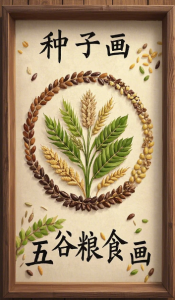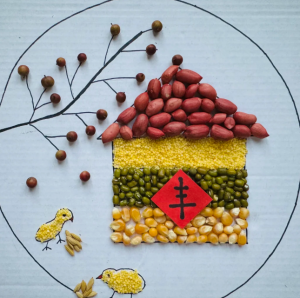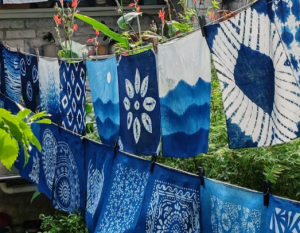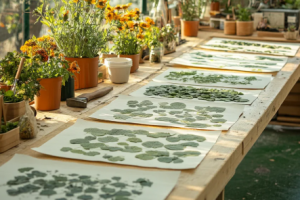In the rich tapestry of Chinese intangible cultural heritage, Seed Mosaic Art (种子画, zhǒngzi huà) stands out for its profound simplicity and beautiful connection to the earth. This unique folk craft transforms humble grains, seeds, and beans into stunning pictorial art. Using nature’s own palette of colors, shapes, and textures, artisans create vibrant and tactile representations of life, blessing, and the natural world.

Sown in Tradition: Historical and Cultural Roots
The exact origins of Seed Mosaic Art are difficult to pinpoint, as it stems from the deep-seated agricultural traditions and folk customs of ancient China.
-
An Agrarian Connection: For millennia, Chinese civilization has been rooted in farming. Seeds were not merely sources of food but symbols of life, hope, and prosperity. The art form naturally emerged from this reverence for the land and its bounty. It is a celebration of the harvest and a testament to the ingenuity of folk artists who found aesthetic value in everyday materials.
-
Folk Symbolism: Like many traditional crafts, seed art is imbued with symbolic meaning. The selection of seeds is deliberate:
-
Red Beans (红豆): Often represent lovesickness and romance, derived from a famous Tang dynasty poem.
-
Soybeans (黄豆): Symbolize the earth and wealth, with their golden hue evoking soil and gold.
-
Black Sesame Seeds (黑芝麻): Used for fine details, sometimes symbolizing longevity or the ink of a scholar.
-
Rice, Millet, and Sorghum: Represent a bumper harvest, abundance, and the blessings of a prosperous life.
-
-
Educational Beginnings: In modern history, this art form has been a staple in kindergartens and primary schools across China, particularly in rural areas. It serves as a low-cost, highly effective tool to teach children about different plant species, develop fine motor skills, and foster an appreciation for nature and patience.
The Art of Harvest: Materials and Creative Process
Creating a seed mosaic is a meditative process that requires a keen eye for design and immense patience. The procedure can be broken down into several key steps:
-
Design and Drafting: The artist first conceives a pattern, often drawing from traditional themes such as the Chinese zodiac, landscapes, flowers, birds, or the character “福” (fú, meaning blessing). This design is then sketched onto a solid backing, such as cardboard, wood, or thick paper.
-
Seed Selection and Preparation: This is the most crucial stage. The artisan collects a variety of seeds, beans, grains, and even spices. They are carefully sorted by size, color, and texture. Some may be dyed to expand the color spectrum, while others are left in their natural state. The seeds are often dried and sometimes varnished to prevent pests and enhance their natural luster.
-
Application and Adhesion: Using tweezers and a small applicator (like a toothpick or brush), the artist applies a strong adhesive (such as white glue) to a small section of the draft. Then, seed by seed, they begin placing them onto the glued area. The seeds can be arranged in different directions to create light and shadow, or combined to form color gradients.
-
Drying and Finishing: Once the entire picture is filled, it is left to dry completely under pressure to ensure all seeds adhere firmly. A final protective sealant, like a clear varnish, may be applied to preserve the artwork from moisture and dust, ensuring its longevity.
The final artwork is a remarkable tactile experience, with its raised surface and intricate patterns inviting both visual and physical engagement.

New Growth: Modern Development and Significance
From a simple folk craft and educational tool, Seed Mosaic Art has grown into a recognized and evolving form of cultural expression.
-
Gaining Cultural Status: While it may not be as widely recognized as some other非遗, seed art is increasingly being valued as a unique part of China’s folk heritage. It is promoted in cultural centers and featured in exhibitions on local crafts.
-
Modern Artistic Expression: Contemporary artists are pushing the boundaries of this traditional medium. They are creating larger, more complex works, incorporating unconventional seeds, and exploring modern themes and abstract designs. This elevates seed art from a children’s craft to a sophisticated art form.
-
Promoting Sustainability: In an age focused on sustainability, seed art resonates deeply as an eco-friendly art form. It utilizes natural, renewable, and often leftover materials, promoting the values of recycling and environmental consciousness.
-
Therapeutic Value: The slow, meticulous, and focused nature of creating seed mosaics is increasingly recognized for its therapeutic benefits, serving as a form of art therapy that reduces stress and promotes mindfulness.
A Lasting Legacy
Seed Mosaic Art is a beautiful dialogue between humanity and nature. It is a testament to the Chinese philosophical ideal of harmony with the natural world, finding artistry in the most fundamental gifts of the earth. Each piece is not just a picture but a collection of countless potential lives, meticulously arranged to tell a story of culture, blessing, and beauty.
As this art form continues to evolve and capture new hearts, it ensures that these tiny seeds of tradition will continue to bear fruit for generations to come.
猜你喜欢
发表评论
电子邮件地址不会被公开。 必填项已用*标注






